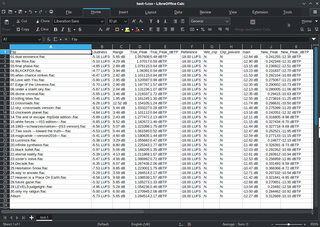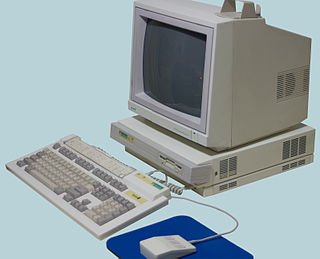Related Research Articles
Lotus 1-2-3 is a discontinued spreadsheet program from Lotus Software. It was the first killer application of the IBM PC, was hugely popular in the 1980s, and significantly contributed to the success of IBM PC-compatibles in the business market.

A spreadsheet is a computer application for computation, organization, analysis and storage of data in tabular form. Spreadsheets were developed as computerized analogs of paper accounting worksheets. The program operates on data entered in cells of a table. Each cell may contain either numeric or text data, or the results of formulas that automatically calculate and display a value based on the contents of other cells. The term spreadsheet may also refer to one such electronic document.

UCSD Pascal is a Pascal programming language system that runs on the UCSD p-System, a portable, highly machine-independent operating system. UCSD Pascal was first released in 1977. It was developed at the University of California, San Diego (UCSD).

VisiCalc is the first spreadsheet computer program for personal computers, originally released for Apple II by VisiCorp on 17 October 1979. It is often considered the application that turned the microcomputer from a hobby for computer enthusiasts into a serious business tool, prompting IBM to introduce the IBM PC two years later. VisiCalc is considered to be Apple II's killer app. It sold over 700,000 copies in six years, and as many as 1 million copies over its history.
Turbo Pascal is a software development system that includes a compiler and an integrated development environment (IDE) for the Pascal programming language running on CP/M, CP/M-86, and DOS. It was originally developed by Anders Hejlsberg at Borland, and was notable for its extremely fast compilation. Turbo Pascal, and the later but similar Turbo C, made Borland a leader in PC-based development.

IBM PC compatible computers are similar to the original IBM PC, XT, and AT, all from computer giant IBM, that are able to use the same software and expansion cards. Such computers were referred to as PC clones, IBM clones or IBM PC clones. The term "IBM PC compatible" is now a historical description only, since IBM no longer sells personal computers after it sold its personal computer division in 2005 to Chinese technology company Lenovo. The designation "PC", as used in much of personal computer history, has not meant "personal computer" generally, but rather an x86 computer capable of running the same software that a contemporary IBM PC could. The term was initially in contrast to the variety of home computer systems available in the early 1980s, such as the Apple II, TRS-80, and Commodore 64. Later, the term was primarily used in contrast to Apple's Macintosh computers.

Acorn Archimedes is a family of personal computers designed by Acorn Computers of Cambridge, England. The systems are based on Acorn's own ARM architecture processors and the proprietary operating systems Arthur and RISC OS. The first models were introduced in 1987, and systems in the Archimedes family were sold until the mid-1990s.
Lotus Symphony was an integrated software package for creating and editing text, spreadsheets, charts and other documents on the MS-DOS operating systems. It was released by Lotus Development as a follow-on to its popular spreadsheet program, Lotus 1-2-3, and was produced from 1984–1992. Lotus Jazz on the Apple Macintosh was a sibling product.
In marketing terminology, a killer application is any computer program or software that is so necessary or desirable that it proves the core value of some larger technology, such as computer hardware, a video game console, software, a programming language, a software platform, or an operating system. In other words, consumers would buy the hardware just to run that application. A killer app can substantially increase sales of the platform on which it runs.

AppleWorks is an integrated office suite containing a word processor, database, and spreadsheet. It was developed by Rupert Lissner for Apple Computer, originally for the Apple II platform and launched in 1984, and was later reworked for the Macintosh platform.
Ashton-Tate Corporation was a US-based software company best known for developing the popular dBASE database application and later acquiring Framework from the Forefront Corporation and MultiMate from Multimate International. It grew from a small garage-based company to become a multinational corporation. Once one of the "Big Three" software companies, which included Microsoft and Lotus, the company stumbled in the late 1980s and was sold to Borland in September 1991.
An application program is a computer program designed to carry out a specific task other than one relating to the operation of the computer itself, typically to be used by end-users. Word processors, media players, and accounting software are examples. The collective noun "application software" refers to all applications collectively. The other principal classifications of software are system software, relating to the operation of the computer, and utility software ("utilities").
The Commodore 64 amassed a large software library of nearly 10,000 commercial titles, covering most genres from games to business applications, and many others.

The TRS-80 Model 100 is a portable computer introduced in 1983. It is one of the first notebook-style computers, featuring a keyboard and liquid crystal display, in a battery-powered package roughly the size and shape of a notepad or large book.

The Epson QX-10 is a microcomputer running CP/M or TPM-III which was introduced in 1983. It was based on a Zilog Z80 microprocessor, running at 4 MHz, provided up to 256 KB of RAM organized in four switchable banks, and included a separate graphics processor chip (µPD7220) manufactured by NEC to provide advanced graphics capabilities. In the USA and Canada, two versions were launched; a basic CP/M configuration with 64 KB RAM and the HASCI configuration with 256 KB RAM and the special HASCI keyboard to be used with the bundled application suite, called Valdocs. TPM-III was used for Valdocs and some copy protected programs like Logo Professor. The European and Japanese versions were CP/M configurations with 256 KB RAM and a graphical Basic interpreter.
Integrated software is a software for personal computers that combines the most commonly used functions of many productivity software programs into one application.
This article deals with productivity software created for the Amiga line of computers and covers the AmigaOS operating system and its derivates AROS and MorphOS and is a split of main article Amiga software. See also related articles Amiga Internet and communications software, Amiga music software, Amiga programming languages, and Amiga support and maintenance software for other information regarding software that run on Amiga.

A personal computer (PC) is a multi-purpose microcomputer whose size, capabilities, and price make it feasible for individual use. Personal computers are intended to be operated directly by an end user, rather than by a computer expert or technician. Unlike large, costly minicomputers and mainframes, time-sharing by many people at the same time is not used with personal computers. Primarily in the late 1970s and 1980s, the term home computer was also used.
Productivity software is application software used for producing information. Its names arose from it increasing productivity, especially of individual office workers, from typists to knowledge workers, although its scope is now wider than that. Office suites, which brought word processing, spreadsheet, and relational database programs to the desktop in the 1980s, are the core example of productivity software. They revolutionized the office with the magnitude of the productivity increase they brought as compared with the pre-1980s office environments of typewriters, paper filing, and handwritten lists and ledgers. In the United States, some 78% of "middle-skill" occupations now require the use of productivity software. In the 2010s, productivity software has become even more consumerized than it already was, as computing becomes ever more integrated into daily personal life.
References
- ↑ "Whatever Happened to Context MBA?". Dvorak Uncensored. Retrieved 2007-12-24.
- ↑ Tracy Robnett Licklider (1989). "Ten Years of Rows and Columns". Byte Magazine . Retrieved 2007-12-24.
- ↑ Zachmann, Mark S. (June 1983). "Context MBA: Half A Step In The Right Direction". PC Magazine. p. 123. Retrieved 21 October 2013.